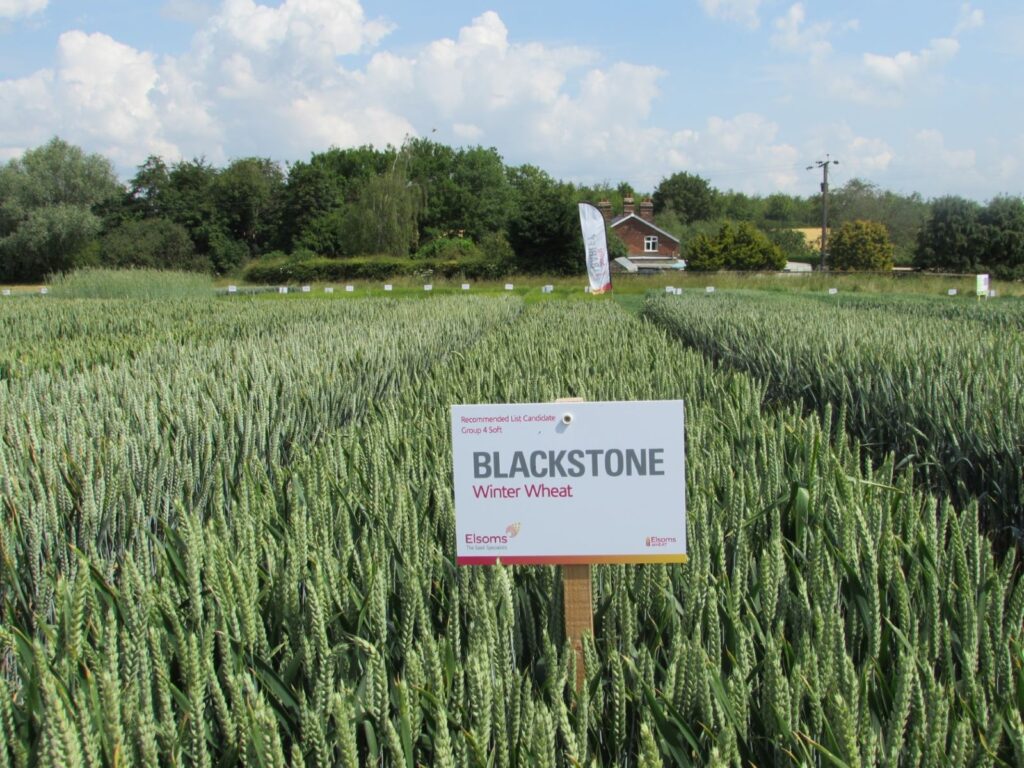Wheat variety’s wide drilling window appeals to Scottish growers
27th September 2023
Blackstone’s exceptionally wide sowing window from mid-September to March looks to be a major benefit to Scottish growers, with Kirkcaldy-based farmer Willie Murray seeing high average yields of 12.5t/ha after sowing the crop for the first time in September last year.
With its high specific weight, solid disease profile and strong traits, including an extremely wide sowing window from mid-September to the following March, the new Group 4 Soft wheat variety has already generated significant interest among seed merchants.
Blackstone, from independent breeder Elsoms Seeds, is currently the highest yielding of this year’s Recommended List (RL) Soft Group 4 candidates and was a first-time crop for Willie Murray, who farms 155ha of combinable crops at Wester Balbeggie farm, just north of Kirkcaldy in Fife.
He said: “Blackstone was recommended to us by seed specialists Harley Seeds, based on its very high treated yield of 105% in the north, and we drilled the crop on September 26th last year at a seed density of 205kg/ha into a medium loam topsoil with clay underneath following a crop of oilseed rape.”
According to Mr Murray, the variety’s early vigour was exceptional, and the crop easily outcompeted the combined weed burden of annual meadow-grass and broad-leaved weeds, coming through in excellent shape following a relatively mild winter.
“Three main splits of Nitrogen were applied, on February 27th, March 31st and April 3rd – with a very small top-up dressing added on April 24th,” he continued. “Before beginning our fungicide program, the crop was rolled in early spring to counter any frost heave and to encourage its roots system, in conjunction with an early applied plant growth regulator (PGR), to go deeper before the drier weather began.”
Following advice from agronomist Duncan Downie from East of Scotland Farmers, the Murrays settled on a four-spray fungicide program beginning with a T0 “half-spray” on 22nd April and ending with a final T3 spray by 22nd June.
Mr Murray noted Blackstone is a very stiff-strawed, tall and lush crop with plenty of fertility, which prompted the application of a PGR at T0, and again at T2 alongside the farm’s main flag leaf spray of mefentrifluconazole + fluxapyroxad + pyraclostrobin for additional insurance.
“Through May – July, and leading up to harvest on August 25th, the crop looked exceptionally clean during a relatively low-pressure disease year in our area,” he remarked. It combined well, producing an excellent amount of straw and a nice, clear bold grain.
“Average specific weight was very high at 81.5kg/hl, with a protein content of 10.3% that prompted an approach from a local flour mill to take the crop with the spec achieved as a soft biscuit wheat.
“Agronomically, the variety was easy to manage, and it stayed very clean, showing no stress despite seeing very little rain between April and June. The second growth kick we got from it after the first N application in the early spring was exceptionally good, and – although it’s not yet on the RL, I will definitely be drilling it again this autumn,” Mr Murray concluded.
A potential ‘game-changer’ for northern growers

Douglas Gordon, managing director of Harley Seeds
Echoing Mr Murray’s endorsement of Blackstone, Douglas Gordon, managing director of Alexander Harley Seeds (Milnathort) Limited, is very positive about the variety’s future and sees its long, flexible drilling window as a potential game changer for many northern and Scottish growers.
“Having first heard about Blackstone last year, I was initially impressed with both its 105% treated yield score in Scottish trials and a robust disease package that includes a 9 for yellow rust, a 6 for brown rust and a 6 for Septoria Tritici,” he said.
“However, with many winter wheat growers in both southern and western Scotland often unable to get a crop in the ground during the winter months, the appeal of a variety able to be sown from mid-September to, potentially, the following March could be its key trait.”
He added the variety looks to be of serious interest to many Scottish growers currently relying on lower-yielding spring wheats, as well as larger acreage winter wheat growers who want to spread their harvest window.
“With positive potential for the distilling market, a high yield, plus its suitability for mixed farms based on an ability to produce a lot of very stiff straw for cattle, if it achieves RL status in November then it should attract serious interest in Scotland,” Mr Gordon noted.
George Goodwin, Elsoms head of Technical, was delighted with both the yield results and grain quality from the JW Murray Blackstone crop and links the positive on-farm performance and its leading position in this year’s RL Candidate trials to the variety’s strong and diverse genetic background.
“Blackstone is a Panacea and Tempo cross. Whilst the benefit of that may not be immediately obvious to a lot of growers, when you look further back into the genetic lines you see that it’s related to outstanding former wheat varieties such as Riband, Consort and Claire.
“This rich history of British soft wheats is a key reason behind our confidence in Blackstone’s quality performance for domestic, export and distilling use,” he explained.
In trials, the variety has exhibited lower than average levels of stress and comes with a strong disease package, including orange wheat blossom midge resistance and sturdy agronomics, Mr Goodwin said.
“I’ve monitored Blackstone’s high yield performance over the last couple of years and am confident that it’s a real contender for northern and Scottish growers,” he concluded.

